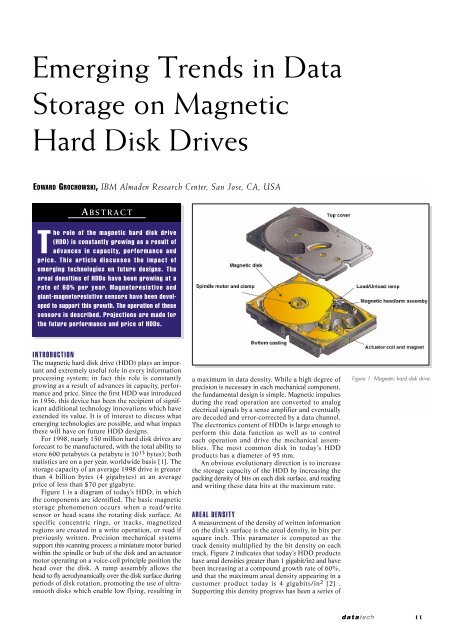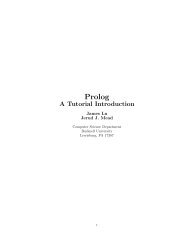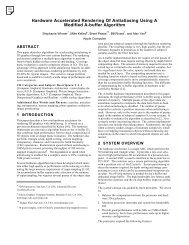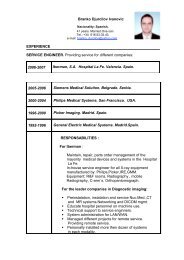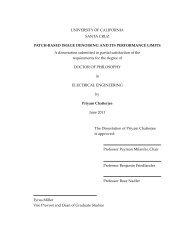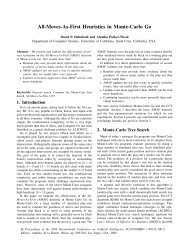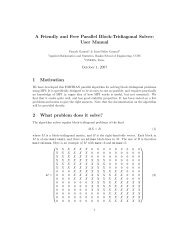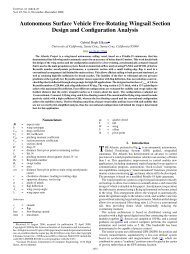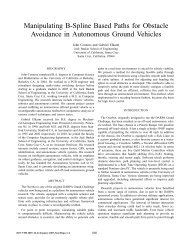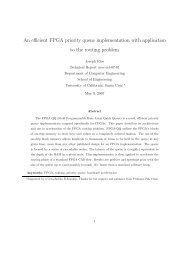Emerging Trends in Data Storage on Magnetic Hard Disk Drives
Emerging Trends in Data Storage on Magnetic Hard Disk Drives
Emerging Trends in Data Storage on Magnetic Hard Disk Drives
You also want an ePaper? Increase the reach of your titles
YUMPU automatically turns print PDFs into web optimized ePapers that Google loves.
<str<strong>on</strong>g>Emerg<str<strong>on</strong>g>in</str<strong>on</strong>g>g</str<strong>on</strong>g> <str<strong>on</strong>g>Trends</str<strong>on</strong>g> <str<strong>on</strong>g>in</str<strong>on</strong>g> <str<strong>on</strong>g>Data</str<strong>on</strong>g><br />
<str<strong>on</strong>g>Storage</str<strong>on</strong>g> <strong>on</strong> <strong>Magnetic</strong><br />
<strong>Hard</strong> <strong>Disk</strong> <strong>Drives</strong><br />
EDWARD GROCHOWSKI, IBM Almaden Research Center, San Jose, CA, USA<br />
A BSTRACT<br />
The role of the magnetic hard disk drive<br />
(HDD) is c<strong>on</strong>stantly grow<str<strong>on</strong>g>in</str<strong>on</strong>g>g as a result of<br />
advances <str<strong>on</strong>g>in</str<strong>on</strong>g> capacity, performance and<br />
price. This article discusses the impact of<br />
emerg<str<strong>on</strong>g>in</str<strong>on</strong>g>g technologies <strong>on</strong> future designs. The<br />
areal densities of HDDs have been grow<str<strong>on</strong>g>in</str<strong>on</strong>g>g at a<br />
rate of 60% per year. Magnetoresistive and<br />
giant-magnetoresistive sensors have been developed<br />
to support this growth. The operati<strong>on</strong> of these<br />
sensors is described. Projecti<strong>on</strong>s are made for<br />
the future performance and price of HDDs.<br />
INTRODUCTION<br />
The magnetic hard disk drive (HDD) plays an important<br />
and extremely useful role <str<strong>on</strong>g>in</str<strong>on</strong>g> every <str<strong>on</strong>g>in</str<strong>on</strong>g>formati<strong>on</strong><br />
process<str<strong>on</strong>g>in</str<strong>on</strong>g>g system; <str<strong>on</strong>g>in</str<strong>on</strong>g> fact this role is c<strong>on</strong>stantly<br />
grow<str<strong>on</strong>g>in</str<strong>on</strong>g>g as a result of advances <str<strong>on</strong>g>in</str<strong>on</strong>g> capacity, performance<br />
and price. S<str<strong>on</strong>g>in</str<strong>on</strong>g>ce the first HDD was <str<strong>on</strong>g>in</str<strong>on</strong>g>troduced<br />
<str<strong>on</strong>g>in</str<strong>on</strong>g> 1956, this device has been the recipient of significant<br />
additi<strong>on</strong>al technology <str<strong>on</strong>g>in</str<strong>on</strong>g>novati<strong>on</strong>s which have<br />
extended its value. It is of <str<strong>on</strong>g>in</str<strong>on</strong>g>terest to discuss what<br />
emerg<str<strong>on</strong>g>in</str<strong>on</strong>g>g technologies are possible, and what impact<br />
these will have <strong>on</strong> future HDD designs.<br />
For 1998, nearly 150 milli<strong>on</strong> hard disk drives are<br />
forecast to be manufactured, with the total ability to<br />
store 600 petabytes (a petabyte is 10 15 bytes); both<br />
statistics are <strong>on</strong> a per year, worldwide basis [1]. The<br />
storage capacity of an average 1998 drive is greater<br />
than 4 billi<strong>on</strong> bytes (4 gigabytes) at an average<br />
price of less than $70 per gigabyte.<br />
Figure 1 is a diagram of today’s HDD, <str<strong>on</strong>g>in</str<strong>on</strong>g> which<br />
the comp<strong>on</strong>ents are identified. The basic magnetic<br />
storage phenomen<strong>on</strong> occurs when a read/write<br />
sensor or head scans the rotat<str<strong>on</strong>g>in</str<strong>on</strong>g>g disk surface. At<br />
specific c<strong>on</strong>centric r<str<strong>on</strong>g>in</str<strong>on</strong>g>gs, or tracks, magnetized<br />
regi<strong>on</strong>s are created <str<strong>on</strong>g>in</str<strong>on</strong>g> a write operati<strong>on</strong>, or read if<br />
previously written. Precisi<strong>on</strong> mechanical systems<br />
support this scann<str<strong>on</strong>g>in</str<strong>on</strong>g>g process; a m<str<strong>on</strong>g>in</str<strong>on</strong>g>iature motor buried<br />
with<str<strong>on</strong>g>in</str<strong>on</strong>g> the sp<str<strong>on</strong>g>in</str<strong>on</strong>g>dle or hub of the disk and an actuator<br />
motor operat<str<strong>on</strong>g>in</str<strong>on</strong>g>g <strong>on</strong> a voice-coil pr<str<strong>on</strong>g>in</str<strong>on</strong>g>ciple positi<strong>on</strong> the<br />
head over the disk. A ramp assembly allows the<br />
head to fly aerodynamically over the disk surface dur<str<strong>on</strong>g>in</str<strong>on</strong>g>g<br />
periods of disk rotati<strong>on</strong>, promot<str<strong>on</strong>g>in</str<strong>on</strong>g>g the use of ultrasmooth<br />
disks which enable low fly<str<strong>on</strong>g>in</str<strong>on</strong>g>g, result<str<strong>on</strong>g>in</str<strong>on</strong>g>g <str<strong>on</strong>g>in</str<strong>on</strong>g><br />
a maximum <str<strong>on</strong>g>in</str<strong>on</strong>g> data density. While a high degree of<br />
precisi<strong>on</strong> is necessary <str<strong>on</strong>g>in</str<strong>on</strong>g> each mechanical comp<strong>on</strong>ent,<br />
the fundamental design is simple. <strong>Magnetic</strong> impulses<br />
dur<str<strong>on</strong>g>in</str<strong>on</strong>g>g the read operati<strong>on</strong> are c<strong>on</strong>verted to analog<br />
electrical signals by a sense amplifier and eventually<br />
are decoded and error-corrected by a data channel.<br />
The electr<strong>on</strong>ics c<strong>on</strong>tent of HDDs is large enough to<br />
perform this data functi<strong>on</strong> as well as to c<strong>on</strong>trol<br />
each operati<strong>on</strong> and drive the mechanical assemblies.<br />
The most comm<strong>on</strong> disk <str<strong>on</strong>g>in</str<strong>on</strong>g> today’s HDD<br />
products has a diameter of 95 mm.<br />
An obvious evoluti<strong>on</strong>ary directi<strong>on</strong> is to <str<strong>on</strong>g>in</str<strong>on</strong>g>crease<br />
the storage capacity of the HDD by <str<strong>on</strong>g>in</str<strong>on</strong>g>creas<str<strong>on</strong>g>in</str<strong>on</strong>g>g the<br />
pack<str<strong>on</strong>g>in</str<strong>on</strong>g>g density of bits <strong>on</strong> each disk surface, and read<str<strong>on</strong>g>in</str<strong>on</strong>g>g<br />
and writ<str<strong>on</strong>g>in</str<strong>on</strong>g>g these data bits at the maximum rate.<br />
AREAL DENSITY<br />
A measurement of the density of written <str<strong>on</strong>g>in</str<strong>on</strong>g>formati<strong>on</strong><br />
<strong>on</strong> the disk’s surface is the areal density, <str<strong>on</strong>g>in</str<strong>on</strong>g> bits per<br />
square <str<strong>on</strong>g>in</str<strong>on</strong>g>ch. This parameter is computed as the<br />
track density multiplied by the bit density <strong>on</strong> each<br />
track. Figure 2 <str<strong>on</strong>g>in</str<strong>on</strong>g>dicates that today’s HDD products<br />
have areal densities greater than 1 gigabit/<str<strong>on</strong>g>in</str<strong>on</strong>g>2 and have<br />
been <str<strong>on</strong>g>in</str<strong>on</strong>g>creas<str<strong>on</strong>g>in</str<strong>on</strong>g>g at a compound growth rate of 60%,<br />
and that the maximum areal density appear<str<strong>on</strong>g>in</str<strong>on</strong>g>g <str<strong>on</strong>g>in</str<strong>on</strong>g> a<br />
customer product today is 4 gigabits/<str<strong>on</strong>g>in</str<strong>on</strong>g> 2 [2] .<br />
Support<str<strong>on</strong>g>in</str<strong>on</strong>g>g this density progress has been a series of<br />
Figure 1. <strong>Magnetic</strong> hard disk drive.<br />
datatech 11
Figure 2. Areal density projecti<strong>on</strong>.<br />
Figure 3. Evoluti<strong>on</strong> of magnetic heads.<br />
12 datatech<br />
laboratory <str<strong>on</strong>g>in</str<strong>on</strong>g>vestigati<strong>on</strong>s of new head designs and<br />
technologies which have resulted <str<strong>on</strong>g>in</str<strong>on</strong>g> 1, 3, 5, and<br />
most recently 11.6 gigabits/<str<strong>on</strong>g>in</str<strong>on</strong>g> 2 . The <str<strong>on</strong>g>in</str<strong>on</strong>g>tent of these<br />
<str<strong>on</strong>g>in</str<strong>on</strong>g>vestigati<strong>on</strong>s is to develop the head technology to<br />
be used <str<strong>on</strong>g>in</str<strong>on</strong>g> future products, and <str<strong>on</strong>g>in</str<strong>on</strong>g> fact a product with<br />
an areal density of 11.6 gigabits/<str<strong>on</strong>g>in</str<strong>on</strong>g> 2 will be very<br />
probable by the year 2001.<br />
Figure 3 shows the evoluti<strong>on</strong> of magnetic heads<br />
to support this growth <str<strong>on</strong>g>in</str<strong>on</strong>g> areal density. Th<str<strong>on</strong>g>in</str<strong>on</strong>g>-film <str<strong>on</strong>g>in</str<strong>on</strong>g>ductive<br />
heads, used for both read<str<strong>on</strong>g>in</str<strong>on</strong>g>g and writ<str<strong>on</strong>g>in</str<strong>on</strong>g>g, were<br />
replaced start<str<strong>on</strong>g>in</str<strong>on</strong>g>g <str<strong>on</strong>g>in</str<strong>on</strong>g> 1991 by magnetoresistive (MR)<br />
read sensors comb<str<strong>on</strong>g>in</str<strong>on</strong>g>ed with <str<strong>on</strong>g>in</str<strong>on</strong>g>ductive write heads,<br />
and <str<strong>on</strong>g>in</str<strong>on</strong>g> 1997 a giant-magnetoresistive (GMR) head<br />
was <str<strong>on</strong>g>in</str<strong>on</strong>g>troduced to c<strong>on</strong>t<str<strong>on</strong>g>in</str<strong>on</strong>g>ue this progress [3]. A<br />
laboratory dem<strong>on</strong>strati<strong>on</strong> at 11.6 gigabits/<str<strong>on</strong>g>in</str<strong>on</strong>g> 2 was<br />
performed us<str<strong>on</strong>g>in</str<strong>on</strong>g>g this GMR head design. New head<br />
design technologies are emerg<str<strong>on</strong>g>in</str<strong>on</strong>g>g to provide further<br />
areal-density <str<strong>on</strong>g>in</str<strong>on</strong>g>creases, <str<strong>on</strong>g>in</str<strong>on</strong>g>volv<str<strong>on</strong>g>in</str<strong>on</strong>g>g advanced GMR structures<br />
or, as reported, tunnel juncti<strong>on</strong> devices [4]. Figure<br />
4 <str<strong>on</strong>g>in</str<strong>on</strong>g>dicates the scal<str<strong>on</strong>g>in</str<strong>on</strong>g>g process for MR and GMR read<br />
sensors s<str<strong>on</strong>g>in</str<strong>on</strong>g>ce 1991. This evoluti<strong>on</strong> <str<strong>on</strong>g>in</str<strong>on</strong>g>volves a reducti<strong>on</strong><br />
<str<strong>on</strong>g>in</str<strong>on</strong>g> sensor length, which <str<strong>on</strong>g>in</str<strong>on</strong>g>creases the track<br />
density, and a reducti<strong>on</strong> <str<strong>on</strong>g>in</str<strong>on</strong>g> film thickness, which determ<str<strong>on</strong>g>in</str<strong>on</strong>g>es<br />
the bit density. Each progressive reducti<strong>on</strong> results<br />
<str<strong>on</strong>g>in</str<strong>on</strong>g> higher areal density and a corresp<strong>on</strong>d<str<strong>on</strong>g>in</str<strong>on</strong>g>gly higher<br />
HDD capacity, and this evoluti<strong>on</strong> is expected to<br />
c<strong>on</strong>t<str<strong>on</strong>g>in</str<strong>on</strong>g>ue throughout this decade and <str<strong>on</strong>g>in</str<strong>on</strong>g>to the next.<br />
MR/GMR OPERATION<br />
Figure 5 details the basic MR and GMR read structures.<br />
For MR sensors a c<strong>on</strong>stant electrical current<br />
is passed through a film of nickel/ir<strong>on</strong> (NiFe) alloy,<br />
creat<str<strong>on</strong>g>in</str<strong>on</strong>g>g a magnetic field <str<strong>on</strong>g>in</str<strong>on</strong>g> the material. As the<br />
sensor approaches a magnetized regi<strong>on</strong> <strong>on</strong> a disk, the<br />
new magnetic field of the magnetized regi<strong>on</strong> results<br />
<str<strong>on</strong>g>in</str<strong>on</strong>g> a change <str<strong>on</strong>g>in</str<strong>on</strong>g> the magnetic field directi<strong>on</strong> <str<strong>on</strong>g>in</str<strong>on</strong>g> the NiFe<br />
film, produc<str<strong>on</strong>g>in</str<strong>on</strong>g>g a voltage change. As shown, this voltage<br />
change is n<strong>on</strong>l<str<strong>on</strong>g>in</str<strong>on</strong>g>ear with the disk magnetic field, and<br />
design<str<strong>on</strong>g>in</str<strong>on</strong>g>g an efficient electr<strong>on</strong>ics system to <str<strong>on</strong>g>in</str<strong>on</strong>g>terpret<br />
these magnetic signals would be difficult. However,<br />
by plac<str<strong>on</strong>g>in</str<strong>on</strong>g>g a sec<strong>on</strong>d film, magnetically soft, <str<strong>on</strong>g>in</str<strong>on</strong>g><br />
proximity with the NiFe MR film, but separated<br />
from it by a high-resistance spacer, the directi<strong>on</strong> of<br />
magnetizati<strong>on</strong> is ma<str<strong>on</strong>g>in</str<strong>on</strong>g>ta<str<strong>on</strong>g>in</str<strong>on</strong>g>ed near 45° <str<strong>on</strong>g>in</str<strong>on</strong>g> the NiFe and<br />
the change <str<strong>on</strong>g>in</str<strong>on</strong>g> voltage is l<str<strong>on</strong>g>in</str<strong>on</strong>g>ear and a maximum.<br />
This structure, labelled SAL (soft adjacent layer), is<br />
the basis for most MR heads <str<strong>on</strong>g>in</str<strong>on</strong>g> the <str<strong>on</strong>g>in</str<strong>on</strong>g>dustry today.<br />
An efficient sense amplifier and data channel design
is possible with HDDs us<str<strong>on</strong>g>in</str<strong>on</strong>g>g SAL MR heads.<br />
As areal density c<strong>on</strong>t<str<strong>on</strong>g>in</str<strong>on</strong>g>ues to <str<strong>on</strong>g>in</str<strong>on</strong>g>crease, MR heads<br />
eventually experience a reducti<strong>on</strong> of this voltage<br />
change, result<str<strong>on</strong>g>in</str<strong>on</strong>g>g <str<strong>on</strong>g>in</str<strong>on</strong>g> lower signal amplitudes. This dropoff<br />
occurs near 5 gigabits/<str<strong>on</strong>g>in</str<strong>on</strong>g> 2 . A new sensor design,<br />
the GMR head, exhibits a significant voltage change<br />
and signal amplitude at areal densities <str<strong>on</strong>g>in</str<strong>on</strong>g> excess of<br />
5 gigabits/<str<strong>on</strong>g>in</str<strong>on</strong>g> 2 . In GMR sensors, two films separated<br />
by a very th<str<strong>on</strong>g>in</str<strong>on</strong>g> c<strong>on</strong>duct<str<strong>on</strong>g>in</str<strong>on</strong>g>g spacer provide the voltagechange<br />
resp<strong>on</strong>se to a disk’s magnetic field. GMR<br />
sensors exploit the fundamental quantum nature of<br />
electr<strong>on</strong>s, and follow the pr<str<strong>on</strong>g>in</str<strong>on</strong>g>ciple that c<strong>on</strong>ducti<strong>on</strong><br />
electr<strong>on</strong>s with their sp<str<strong>on</strong>g>in</str<strong>on</strong>g> directi<strong>on</strong> parallel to the films’<br />
magnetic directi<strong>on</strong> can move freely through the<br />
structure, produc<str<strong>on</strong>g>in</str<strong>on</strong>g>g little voltage change. One film<br />
<str<strong>on</strong>g>in</str<strong>on</strong>g> the GMR structure has a fixed magnetic orientati<strong>on</strong>,<br />
p<str<strong>on</strong>g>in</str<strong>on</strong>g>ned by c<strong>on</strong>tact with an antiferromagnetic<br />
exchange film. The sec<strong>on</strong>d film has a variable<br />
magnetic orientati<strong>on</strong> determ<str<strong>on</strong>g>in</str<strong>on</strong>g>ed by the disk’s<br />
magnetic field. When both fixed and p<str<strong>on</strong>g>in</str<strong>on</strong>g>ned films have<br />
a parallel magnetic orientati<strong>on</strong>, c<strong>on</strong>ducti<strong>on</strong> electr<strong>on</strong>s<br />
may travel l<strong>on</strong>g distances through each film, cross<str<strong>on</strong>g>in</str<strong>on</strong>g>g<br />
the spacer. <strong>Magnetic</strong> fields orig<str<strong>on</strong>g>in</str<strong>on</strong>g>at<str<strong>on</strong>g>in</str<strong>on</strong>g>g from record<str<strong>on</strong>g>in</str<strong>on</strong>g>g<br />
data bits <strong>on</strong> the disk surface rotate the free film’s orientati<strong>on</strong>,<br />
prevent<str<strong>on</strong>g>in</str<strong>on</strong>g>g electr<strong>on</strong> travel because of frequent<br />
collisi<strong>on</strong>s by the electr<strong>on</strong>s. The magnetic orientati<strong>on</strong><br />
sw<str<strong>on</strong>g>in</str<strong>on</strong>g>gs with<str<strong>on</strong>g>in</str<strong>on</strong>g> the free NiFe film are much greater <str<strong>on</strong>g>in</str<strong>on</strong>g><br />
GMR sensors than <str<strong>on</strong>g>in</str<strong>on</strong>g> MR sensors, produc<str<strong>on</strong>g>in</str<strong>on</strong>g>g <str<strong>on</strong>g>in</str<strong>on</strong>g>creased<br />
signal amplitude changes, nearly twice as large,<br />
which are ideally suited for high areal densities.<br />
GMR heads are <str<strong>on</strong>g>in</str<strong>on</strong>g> producti<strong>on</strong> today for use <str<strong>on</strong>g>in</str<strong>on</strong>g> highcapacity<br />
HDDs for server, desktop and mobile<br />
computer platforms. New HDD designs employ<str<strong>on</strong>g>in</str<strong>on</strong>g>g<br />
GMR heads are likely to c<strong>on</strong>t<str<strong>on</strong>g>in</str<strong>on</strong>g>ue the 60% growth<br />
rate <str<strong>on</strong>g>in</str<strong>on</strong>g> areal density <str<strong>on</strong>g>in</str<strong>on</strong>g> the near future, result<str<strong>on</strong>g>in</str<strong>on</strong>g>g <str<strong>on</strong>g>in</str<strong>on</strong>g><br />
progressively higher HDD capacities.<br />
PERFORMANCE<br />
Figure 6 <str<strong>on</strong>g>in</str<strong>on</strong>g>dicates that the data rate, the rate at<br />
which bits of data are written to and read from the<br />
rotat<str<strong>on</strong>g>in</str<strong>on</strong>g>g disk, is <str<strong>on</strong>g>in</str<strong>on</strong>g>creas<str<strong>on</strong>g>in</str<strong>on</strong>g>g with time at a significant<br />
pace. This orig<str<strong>on</strong>g>in</str<strong>on</strong>g>ates from <str<strong>on</strong>g>in</str<strong>on</strong>g>creases <str<strong>on</strong>g>in</str<strong>on</strong>g> bit density as<br />
well as disk rotati<strong>on</strong> rate. Today’s server products have<br />
<str<strong>on</strong>g>in</str<strong>on</strong>g>ternal data rates <str<strong>on</strong>g>in</str<strong>on</strong>g> excess of 20 megabytes/sec and<br />
this is expected to at least double by the year 2000.<br />
The performance of the electr<strong>on</strong>ic data channels<br />
will exceed 500 MHz to allow these very high data<br />
rates, requir<str<strong>on</strong>g>in</str<strong>on</strong>g>g the very latest CMOS process<str<strong>on</strong>g>in</str<strong>on</strong>g>g at<br />
photolithographic l<str<strong>on</strong>g>in</str<strong>on</strong>g>e widths approach<str<strong>on</strong>g>in</str<strong>on</strong>g>g 0.25<br />
µm. This trend <str<strong>on</strong>g>in</str<strong>on</strong>g> <str<strong>on</strong>g>in</str<strong>on</strong>g>ternal data rate closely determ<str<strong>on</strong>g>in</str<strong>on</strong>g>es<br />
the <str<strong>on</strong>g>in</str<strong>on</strong>g>terface rate at which the HDD communicates<br />
with a computer. A new trend <str<strong>on</strong>g>in</str<strong>on</strong>g> high-data-rate<br />
electr<strong>on</strong>ics, from the data channel to the arm amplifiers<br />
and the c<strong>on</strong>troller chips, will be comb<str<strong>on</strong>g>in</str<strong>on</strong>g>ed<br />
with higher levels of electr<strong>on</strong>ics <str<strong>on</strong>g>in</str<strong>on</strong>g>tegrati<strong>on</strong> to reduce<br />
the circuit chip count, thereby m<str<strong>on</strong>g>in</str<strong>on</strong>g>imiz<str<strong>on</strong>g>in</str<strong>on</strong>g>g the<br />
electr<strong>on</strong>ics price and power dissipati<strong>on</strong> and improv<str<strong>on</strong>g>in</str<strong>on</strong>g>g<br />
performance.<br />
<str<strong>on</strong>g>Data</str<strong>on</strong>g> channel design will evolve from the c<strong>on</strong>venti<strong>on</strong>al<br />
PRML (partial-resp<strong>on</strong>se maximum-likelihood)<br />
channel technology to new levels of high-speed data<br />
detecti<strong>on</strong>, analysis and encod<str<strong>on</strong>g>in</str<strong>on</strong>g>g/decod<str<strong>on</strong>g>in</str<strong>on</strong>g>g. Many of<br />
these designs are currently <str<strong>on</strong>g>in</str<strong>on</strong>g> the test<str<strong>on</strong>g>in</str<strong>on</strong>g>g phase <str<strong>on</strong>g>in</str<strong>on</strong>g> the<br />
laboratory. Additi<strong>on</strong>al challenges <str<strong>on</strong>g>in</str<strong>on</strong>g> the design of <str<strong>on</strong>g>in</str<strong>on</strong>g>ductive<br />
write heads, as well as the write driver circuitry,<br />
will c<strong>on</strong>stitute a new field for the magnetic physicist<br />
to address, based <strong>on</strong> magnetic signals with very<br />
short pulse widths at 500 MHz and greater.<br />
Figure 4. Projected evoluti<strong>on</strong> of MR/GMR sensors.<br />
PRICE<br />
Figure 7 shows the reducti<strong>on</strong> <str<strong>on</strong>g>in</str<strong>on</strong>g> price per megabyte<br />
for HDDs compared with DRAM electr<strong>on</strong>ic circuits<br />
[5]. On the basis of improvements <str<strong>on</strong>g>in</str<strong>on</strong>g> areal density<br />
at 60% per year, and assum<str<strong>on</strong>g>in</str<strong>on</strong>g>g <strong>on</strong>ly a modest decl<str<strong>on</strong>g>in</str<strong>on</strong>g>e<br />
<str<strong>on</strong>g>in</str<strong>on</strong>g> unit price, the price per megabyte would be<br />
expected to improve by nearly 40% per year for HDDs,<br />
as shown. If areal density progress were to c<strong>on</strong>t<str<strong>on</strong>g>in</str<strong>on</strong>g>ue<br />
at this 60% rate, HDD prices would be expected to<br />
decl<str<strong>on</strong>g>in</str<strong>on</strong>g>e further, atta<str<strong>on</strong>g>in</str<strong>on</strong>g><str<strong>on</strong>g>in</str<strong>on</strong>g>g a $0.03 per megabyte level<br />
by the year 2000. Eventually, the price per megabyte<br />
would be expected to be reduced below this level <str<strong>on</strong>g>in</str<strong>on</strong>g><br />
the next decade.<br />
SUMMARY<br />
The additi<strong>on</strong> of new technology has been shown to<br />
expand the capabilities of HDDs over the past 40 years,<br />
and this storage device is an <str<strong>on</strong>g>in</str<strong>on</strong>g>tegral part of every <str<strong>on</strong>g>in</str<strong>on</strong>g>formati<strong>on</strong><br />
process<str<strong>on</strong>g>in</str<strong>on</strong>g>g system. New head technologies have<br />
been a key element <str<strong>on</strong>g>in</str<strong>on</strong>g> this progress, and this is<br />
expected to c<strong>on</strong>t<str<strong>on</strong>g>in</str<strong>on</strong>g>ue with the transiti<strong>on</strong> from MR to<br />
GMR heads. New head and disk structures are<br />
under <str<strong>on</strong>g>in</str<strong>on</strong>g>vestigati<strong>on</strong> <str<strong>on</strong>g>in</str<strong>on</strong>g> the laboratory which will<br />
expand areal densities bey<strong>on</strong>d 10 Gbits/<str<strong>on</strong>g>in</str<strong>on</strong>g> 2 by the year<br />
2000.<br />
Figure 8 <str<strong>on</strong>g>in</str<strong>on</strong>g>dicates that a significant evoluti<strong>on</strong> <str<strong>on</strong>g>in</str<strong>on</strong>g><br />
disk drive form factor has occurred over the past 10-<br />
20 years. HDD sizes have progressively decreased from<br />
14 <str<strong>on</strong>g>in</str<strong>on</strong>g>ch diameter disks <str<strong>on</strong>g>in</str<strong>on</strong>g> the 3380 family of HDDs<br />
to the 3.5 <str<strong>on</strong>g>in</str<strong>on</strong>g>ch form factor which c<strong>on</strong>stitutes the high-<br />
datatech 13
14 datatech<br />
Figure 5. Structures of MR and GMR read sensors.<br />
capacity, high-performance HDD of today. The<br />
capacity of this form factor is 18 gigabytes today and<br />
would be expected to approach 100 gigabytes <str<strong>on</strong>g>in</str<strong>on</strong>g>to<br />
the next decade. Bey<strong>on</strong>d this, further capacity<br />
Figure 6. Trend of <str<strong>on</strong>g>in</str<strong>on</strong>g>ternal (media) data rate.<br />
<str<strong>on</strong>g>in</str<strong>on</strong>g>creases are possible, c<strong>on</strong>current with areal density.<br />
The 2.5 <str<strong>on</strong>g>in</str<strong>on</strong>g>ch form factor used today for the mobile<br />
computer platform can also be seen to <str<strong>on</strong>g>in</str<strong>on</strong>g>crease <str<strong>on</strong>g>in</str<strong>on</strong>g><br />
capacity bey<strong>on</strong>d 100 gigabytes <str<strong>on</strong>g>in</str<strong>on</strong>g> the next decade. S<str<strong>on</strong>g>in</str<strong>on</strong>g>ce
the <str<strong>on</strong>g>in</str<strong>on</strong>g>ternal data rate is moderated with smallerdiameter<br />
disks, it is possible to expect extensi<strong>on</strong> of<br />
65 mm disks, used <str<strong>on</strong>g>in</str<strong>on</strong>g> 2.5 <str<strong>on</strong>g>in</str<strong>on</strong>g>ch HDDs, <str<strong>on</strong>g>in</str<strong>on</strong>g>to the highrotati<strong>on</strong>-rate<br />
and high-performance market <str<strong>on</strong>g>in</str<strong>on</strong>g> the<br />
future.<br />
The attractive price and expanded capacity of HDDs<br />
would be expected also to extend their applicati<strong>on</strong><br />
to c<strong>on</strong>sumer, n<strong>on</strong>-<str<strong>on</strong>g>in</str<strong>on</strong>g>formati<strong>on</strong>-process<str<strong>on</strong>g>in</str<strong>on</strong>g>g markets.<br />
Figure 8 shows a 1 <str<strong>on</strong>g>in</str<strong>on</strong>g>ch drive design, c<strong>on</strong>ta<str<strong>on</strong>g>in</str<strong>on</strong>g><str<strong>on</strong>g>in</str<strong>on</strong>g>g GMR<br />
heads, a load/unload mechanism and other advanced<br />
features. If this design is possible, it could be very<br />
competitive <str<strong>on</strong>g>in</str<strong>on</strong>g> mobile applicati<strong>on</strong>s such as digital<br />
cameras, hand-held communicati<strong>on</strong> devices and<br />
other areas where flash memory cards are used<br />
today. While Figure 7 dem<strong>on</strong>strated the obvious<br />
price-per-megabyte advantage of HDDs over flash or<br />
DRAM memory, a 1 <str<strong>on</strong>g>in</str<strong>on</strong>g>ch drive would have a higher<br />
price per megabyte than the average higher-capacity<br />
HDD, although this would still be much lower than<br />
the equivalent semic<strong>on</strong>ductor storage device.<br />
Additi<strong>on</strong>al advances <str<strong>on</strong>g>in</str<strong>on</strong>g> materials and structures<br />
of disk media will c<strong>on</strong>currently improve areal density<br />
and performance. The transiti<strong>on</strong> of the disk substrate<br />
to glass or glass/ceramic has improved the mechanical<br />
properties related to the modulus, as well as the<br />
ultimate smoothness of the substrate and overly<str<strong>on</strong>g>in</str<strong>on</strong>g>g<br />
magnetic film. Glass appears to be the ultimate<br />
directi<strong>on</strong> for all HDDs of the future. Improvements<br />
<str<strong>on</strong>g>in</str<strong>on</strong>g> magnetic materials and structures will address the<br />
superparamagnetic effect, reported to be important<br />
at areal densities bey<strong>on</strong>d 40 gigabits/<str<strong>on</strong>g>in</str<strong>on</strong>g> 2 . These<br />
Figure 7. Projecti<strong>on</strong> of average price per megabyte for HDDs and DRAMs.<br />
improvements will <str<strong>on</strong>g>in</str<strong>on</strong>g>volve new, more magnetically<br />
stable films such as samarium-cobalt and very small<br />
gra<str<strong>on</strong>g>in</str<strong>on</strong>g> sizes, below 10 nm. All of these represent a<br />
challenge to the HDD designer and magnetic physicist,<br />
but are <str<strong>on</strong>g>in</str<strong>on</strong>g> the realm of str<strong>on</strong>g possibilities for<br />
future HDDs. The usefulness of this device and the<br />
absence of alternative storage technologies will<br />
ensure that significant <str<strong>on</strong>g>in</str<strong>on</strong>g>vestigati<strong>on</strong>s will c<strong>on</strong>t<str<strong>on</strong>g>in</str<strong>on</strong>g>ue<br />
to be directed towards improvements <str<strong>on</strong>g>in</str<strong>on</strong>g> capacity and<br />
performance.<br />
REFERENCES<br />
[1] J.N. Porter, “The disk drive <str<strong>on</strong>g>in</str<strong>on</strong>g>dustry: balanc<str<strong>on</strong>g>in</str<strong>on</strong>g>g the<br />
demands of technology and markets”, presented<br />
at <strong>Disk</strong>C<strong>on</strong> ‘98 Japan, Tokyo, April l5-17, 1998.<br />
[2] E. Grochowski and D.A. Thomps<strong>on</strong>, “Outlook for<br />
ma<str<strong>on</strong>g>in</str<strong>on</strong>g>ta<str<strong>on</strong>g>in</str<strong>on</strong>g><str<strong>on</strong>g>in</str<strong>on</strong>g>g areal density growth <str<strong>on</strong>g>in</str<strong>on</strong>g> magnetic<br />
record<str<strong>on</strong>g>in</str<strong>on</strong>g>g”, IEEE Trans. <strong>Magnetic</strong>s, Vol. 30, No.<br />
6, 1994, pp. 3797-3800.<br />
[3] Ch<str<strong>on</strong>g>in</str<strong>on</strong>g>g Tsang, et al., “Design, fabricati<strong>on</strong> and<br />
test<str<strong>on</strong>g>in</str<strong>on</strong>g>g of sp<str<strong>on</strong>g>in</str<strong>on</strong>g> valve heads for high density<br />
record<str<strong>on</strong>g>in</str<strong>on</strong>g>g”, IEEE Trans. <strong>Magnetic</strong>s, Vol. 30, No.<br />
6, 1994, pp. 3801-3806.<br />
datatech 15
16 datatech<br />
Figure 8. Evoluti<strong>on</strong> <str<strong>on</strong>g>in</str<strong>on</strong>g> disk drive form factor.<br />
[4] K. Kobayashi, “Sp<str<strong>on</strong>g>in</str<strong>on</strong>g>-dependent tunnel<str<strong>on</strong>g>in</str<strong>on</strong>g>g MR<br />
sensors”, presented at <strong>Disk</strong>C<strong>on</strong> ‘98 Japan, Tokyo,<br />
April 15-17, 1998.<br />
[5] E. Grochowski and R.F. Hoyt, “Future trends <str<strong>on</strong>g>in</str<strong>on</strong>g><br />
hard disk drives”, IEEE Trans. <strong>Magnetic</strong>s, Vol. 32,<br />
No. 3, 1966, pp. 1850-1854.<br />
ABOUT THE AUTHOR<br />
Edward Grochowski is Program<br />
Manager of <str<strong>on</strong>g>Storage</str<strong>on</strong>g> Devices at IBM’s<br />
Almaden Research Center. He began<br />
his career with IBM <str<strong>on</strong>g>in</str<strong>on</strong>g> 1961 <str<strong>on</strong>g>in</str<strong>on</strong>g> New<br />
York help<str<strong>on</strong>g>in</str<strong>on</strong>g>g to develop IBM’s microelectr<strong>on</strong>ic<br />
silic<strong>on</strong> activity, and later jo<str<strong>on</strong>g>in</str<strong>on</strong>g>ed the <str<strong>on</strong>g>Storage</str<strong>on</strong>g> Systems<br />
Divisi<strong>on</strong>, San Jose, California, where he has held technical and<br />
management positi<strong>on</strong>s. His <str<strong>on</strong>g>in</str<strong>on</strong>g>terests <str<strong>on</strong>g>in</str<strong>on</strong>g>clude disk drive comp<strong>on</strong>ent<br />
design and drive form factor development, which have c<strong>on</strong>tributed<br />
to IBM’s latest storage products. Dr Grochowski holds<br />
n<str<strong>on</strong>g>in</str<strong>on</strong>g>e patents. He has a PhD from New York University, held the<br />
positi<strong>on</strong> of Adjunct Professor of Chemical Eng<str<strong>on</strong>g>in</str<strong>on</strong>g>eer<str<strong>on</strong>g>in</str<strong>on</strong>g>g at the<br />
University and was also associated with the University of<br />
Michigan Semic<strong>on</strong>ductor Research Lab. Dr Grochowski is a<br />
member of the board of directors of IDEMA, the Internati<strong>on</strong>al<br />
<strong>Disk</strong> Drive Equipment and Materials Associati<strong>on</strong>, and also participates<br />
<str<strong>on</strong>g>in</str<strong>on</strong>g> the technical programme committee for this organizati<strong>on</strong>.<br />
IF YOU HAVE ANY ENQUIRIES REGARDING THE<br />
CONTENT OF THIS ARTICLE, PLEASE CONTACT:<br />
Dr Edward Grochowski<br />
IBM Almaden Research Center<br />
650 Harry Road<br />
K61/C2<br />
San Jose<br />
CA 95120-6099<br />
USA<br />
Tel: +1 (408) 927 2043<br />
Fax: +1 (408) 927 3520<br />
E-mail: grchwski@almaden.ibm.com


